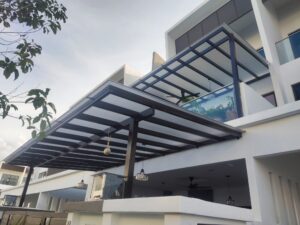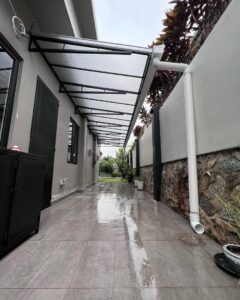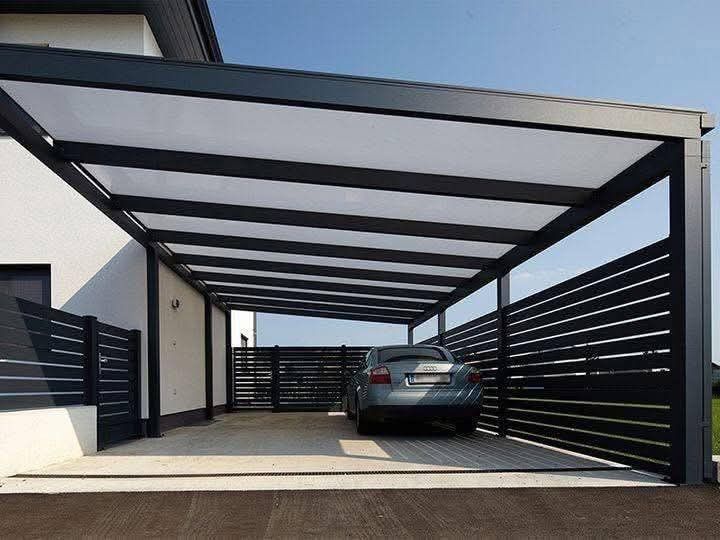ACP vs Polycarbonate Awning: Which One Is Right for You?
ACP vs Polycarbonate Canopy, Compare Pros, Cons & Cost
In Malaysia’s hot and rainy climate, awnings are more than just decorative features—they’re functional roofing extensions that offer protection from sun and rain, help reduce indoor temperature, and add value to your home or business. Whether you’re covering a car porch, balcony, side entrance, or shopfront, choosing the right awning material is crucial.
Two of the most popular awning materials in the Malaysian market today are ACP (Aluminum Composite Panel) and polycarbonate. Each has its strengths, weaknesses, and ideal use cases. In this article, we’ll dive into their functions, appearance, durability, pricing, and more to help you make an informed decision.

What is an ACP ?
ACP stands for Aluminum Composite Panel. It is made by bonding two layers of aluminum sheets to a polyethylene (PE) or fire-retardant core. ACP panels are lightweight, flat, and come in a variety of solid and metallic finishes. This material is widely used in commercial building façades, signboards, and increasingly for residential car porch awnings.
Appearance:
ACP offers a modern, clean, and minimalistic look. Its rigid flatness creates a premium appearance, which is why it’s commonly seen in high-end residential and commercial awnings.
Common Uses in Malaysia:
-
Car porch roofing
-
Shopfront canopy
-
Balcony covers
-
Side shading panels

What is a Polycarbonate ?
Polycarbonate is a transparent or tinted thermoplastic material that is lightweight yet impact-resistant. Polycarbonate sheets can come in flat or corrugated form, with single, twin-wall, or multi-wall layers, often coated with UV protection to prevent yellowing and brittleness from sun exposure.
Appearance:
Polycarbonate awnings are ideal for those who want filtered sunlight while blocking harmful UV rays. They are available in a variety of tints such as clear, bronze, grey, green, or blue.
Common Uses in Malaysia:
-
Patio or backyard roofing
-
Balcony and side entrance covers
-
Shop lot window awnings
-
Walkway or corridor shelters
ACP vs Polycarbonate: Comparison Table
| Feature | ACP Awning | Polycarbonate Awning |
|---|
| Material | Aluminum + PE/FR core | Thermoplastic polymer |
| Light Transmission | Blocks most light (opaque) | Allows natural light, filters UV |
| Appearance | Solid, flat, modern | Sleek, semi-transparent, colored or clear |
| Heat Resistance | Excellent | Good (with UV coating) |
| Weight | Heavier | Lightweight |
| Durability | High, long-lasting | Good, but prone to scratches |
| Maintenance | Low | Moderate (dust and algae need regular cleaning) |
| Cost (Material) | Lower per sq ft | Higher per sq ft |
| Installation Cost | Higher due to framing requirement | Moderate |
| Lifespan | 10–15 years or more | 5–10 years depending on exposure |
| Best For | Car porch, shops, solid roof style | Balcony, backyard, where light is desired |

Pros and Cons of ACP
✅ Pros:
-
Modern Look: Sleek, solid appearance fits minimalist or commercial designs
-
Blocks Heat Completely: Perfect for car porches or areas needing full shade
-
Strong and Durable: Resistant to denting and corrosion
-
Low Maintenance: Dirt doesn’t cling easily to aluminum surfaces
❌ Cons:
-
No Natural Light: Not suitable if you want daylight to enter
-
Heavier Material: Needs stronger structure to support
-
Less Flexible in Shape: Typically flat only, not curved or arched
Pros and Cons of Polycarbonate
✅ Pros:
-
Natural Light: Allows daylight in while reducing heat and UV
-
Design Flexibility: Can be curved, bent, or shaped easily
-
Lightweight: Easier and quicker to install
-
Affordable Installation: Frame structure can be lighter and less costly
❌ Cons:
-
Scratches Easily: Surface can mark if not cleaned properly
-
Can Yellow Over Time: Especially with cheaper or uncoated sheets
-
Needs Frequent Cleaning: Especially in dusty or humid environments
7. Price Comparison in Malaysia (Estimated Range)
Which One Should You Choose?
Your final choice depends on what matters most to you: appearance, function, or budget.
Choose ACP if:
-
You prefer a solid, modern look
-
You want maximum heat and rain protection
-
You’re covering large areas like car porches or commercial shops
-
You’re okay with a slightly higher structural cost for long-term durability
Choose Polycarbonate if:
-
You want natural light with UV protection
-
You’re building a balcony, side entrance, or patio awning
-
You prefer a lighter, more flexible material
-
You’re working on a tighter budget or want something visually light and airy
Frequently Asked Questions (FAQs)
Q: Which lasts longer—ACP or polycarbonate ?
A: ACP generally lasts longer (10–15+ years) with low maintenance. Polycarbonate typically lasts 5–10 years depending on quality and exposure.
Q: Can I use polycarbonate for a car porch?
A: Yes, but be aware that it allows light and some heat through. If full shading is needed, ACP is better.
Q: Is ACP waterproof?
A: Yes. ACP panels are weather-resistant and provide excellent rain protection when installed correctly.
Q: Will polycarbonate sheets turn yellow?
A: Lower-quality or non-UV-coated sheets may yellow over time. Choose high-quality UV-coated sheets to prevent this.
Conclusion: Make the Right Awning Choice for Your Space
Both ACP and polycarbonate awnings have their own distinct advantages. If you’re looking for full protection, modern aesthetics, and long-term durability, ACP are a solid choice. If you need lightweight, semi-transparent coverage with cost efficiency and natural light, polycarbonate offer flexibility and great value.
Before deciding, always consider:
-
What area are you covering?
-
Do you want light to pass through?
-
What’s your budget?
-
Are you planning for aesthetics, functionality, or both?
Lastly, work with a trusted awning contractor in Malaysia who can advise based on your specific location, structure, and budget.
Section Title
Awning
ByAlan
June 24, 2025
Blog Post,ACP awning VS Polycarbonate,Awning
ACP vs Polycarbonate Awning: Which One Is Right for You? ACP vs Polycarbonate Awning, Compare Pros, Cons & Cost In Malaysia’s hot and rainy climate, awnings are more than just decorative…
Read More
Blogs
ByAlan
May 11, 2025
Aluminum Window
Aluminum Windows How Many Common Types of Aluminum Windows in the Malaysia Market? Discover 5 common aluminum windows types in Malaysia—casement, top hung, sliding, folding, and fixed glass. Learn…
Read More
Section Title
Awning
ByAlan
June 24, 2025
Blog Post,ACP awning VS Polycarbonate,Awning
ACP vs Polycarbonate Awning: Which One Is Right for You? ACP vs Polycarbonate Awning, Compare Pros…
Read More
Blogs
ByAlan
May 11, 2025
Aluminum Window
Aluminum Windows How Many Common Types of Aluminum Windows in the Malaysia Market? Discover 5 common…
Read More
